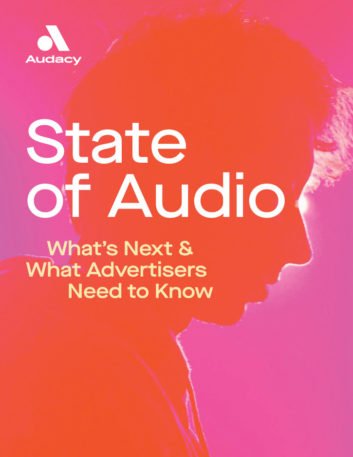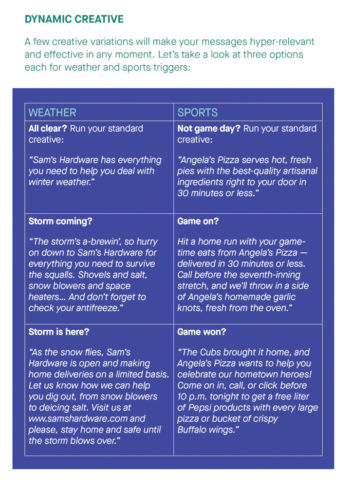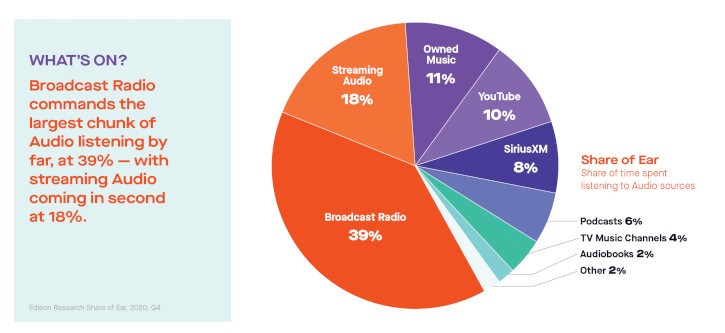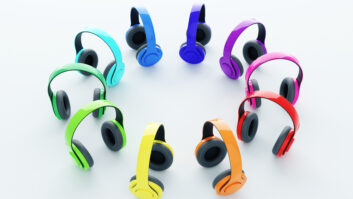 Entercom picked the Audacy name for a reason. Chairman David Field told his hometown newspaper the Philadelphia Inquirer that the old name no longer fit: “Entercom reflected radio only. We’ve outgrown it. It’s broader than that, and it also didn’t fit our aspirations.”
Entercom picked the Audacy name for a reason. Chairman David Field told his hometown newspaper the Philadelphia Inquirer that the old name no longer fit: “Entercom reflected radio only. We’ve outgrown it. It’s broader than that, and it also didn’t fit our aspirations.”
Audacy’s aspirations are now on full display in a wonderful new piece titled “State of Audio — What’s Next & What Advertisers Need To Know.”
It’ll take you at least 30 minutes to absorb this detailed 40-page promotional piece. Worth it? Yes! This is a must-read for everyone in broadcasting, podcasting, audio services or advertising. The nicely designed layout makes it easy to find sections that are of specific interest, but this statement of purpose is best digested whole.
It begins with a lovely, if hyperbolic line: “Advertisers who want to engage deeply with audiences are embracing Audio like never before.”
This intro makes me smile because it’s mostly true and offers promise for the future. The amusing part is that young media buyers will likely believe this line, not knowing much about broadcast radio’s many decades of dominance prior to television.

While it may appear I’m poking fun here, I’m impressed with the way Audacy restates audio’s selling proposition saying, “New research affirms that Audio stirs emotion like no other medium.”
Audacy Chief Digital Officer J.D. Crowley states: “In a world where screen time has reached a new and sometimes uncomfortable peak, it’s the ears, not the eyes, that always connected most deeply. And it’s the ears that are generating the most excitement and energy in media today.”
So true. And it’s so important that a generation of advertising newbies receives this education.
There are sections of metrics that lay out the growth of smart speakers, podcasts and at-home listening. Audio is described as an immersive experience, beating out video, television and even social media. Your local sales staff should understand this playing field and be prepared to discuss it with clients.
There’s a terrific section on podcast listening, revenue generation, and a proposition on how to reach youthful audiences. Celebrities are rightly repackaged as Influencers with instructions on how to utilize their trust to generate results. I particularly enjoyed the “right moment, right message” section on how dynamic creative can run at just the right moment to match the weather, sports, or other events.
The final chapter paints a future for audio based on voice-commands (like shopping by voice), the cloud and the arrival of 5G. Nothing about the smart dashboard in a car, which seems like a miss.

The elephant in the room for our industry shows up on a graph from Edison Research on page 8, concerning the use of broadcast radio. There’s an attempt to paint a rosy picture with broadcast radio commanding the largest percentage of audio listening at 39%. If accurate, that’s a sad state of affairs. Those at the top would be wise to admit that it’s past time to invest significant time, energy and money into stopping this decline and determine how to start a resurgence for broadcast stations.
Audacy has proven its prowess at positioning new forms of audio for the future.
The fly in the formula: According to RAB/Borrell Associates data, digital ad revenue in 2020 hit $1.1 billion. This accounts for about 14% of total ad sales. While it’s fantastic to see digital sales growing for radio, without broadcast station revenue, the business model doesn’t work.
Can Audacy and other leaders leverage their clearly proven creativity to rejuvenate our core broadcast radio product? That’s a manifesto I hope to read in the near future.
Comment on this or any article. Email [email protected].







